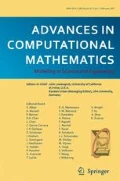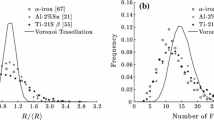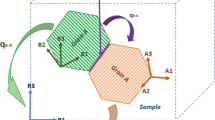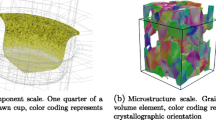Abstract
Complex physical models depending on microstructures developing over time often result in simulation schemes that are very demanding concerning computational time. The two-scale model considered in the current presentation describes a phase transition of a binary mixture with the evolution of equiaxed dendritic microstructures. It consists of a macroscopic heat equation and a family of microscopic cell problems modeling the phase transition. Those phase transitions need to be resolved by very fine computational meshes leading to the demanding numerical complexity. The current study presents a reduced version of this two-scale model. The reduction aims at accelerating the microscopic model, which is parametrized by the macroscopic temperature, while maintaining the accuracy of the detailed system. Parameter dependency, non-linearity, time-dependency, coupled field-variables and high solution complexity are challenging difficulties. They are addressed by a combination of several approaches: Proper Orthogonal Decomposition (POD), Empirical Interpolation Method (EIM) and a partitioning approach generating sub-models for different solution regimes. A new partitioning criterion based on feature extraction is applied. The applicability of the reduction scheme is demonstrated experimentally: while the accuracy is largely maintained, the dimensionality of the detailed model and the computation time are reduced significantly.
Similar content being viewed by others
References
Albrecht, F., Haasdonk, B., Kaulmann, S., Ohlberger, M.: The localized reduced basis multiscale method. In: Proceedings of Algorithmy 2012, pp. 393–403 (2012)
Barrault, M., Maday, Y., Nguyen, N.C., Patera, A.T.: An ‘empirical interpolation’ method: Application to efficient reduced-basis discretization of partial differential equations. C. R. Acad. Sci. Paris Series I 339, 667–672 (2004)
Boyaval, S.: Reduced-basis approach for homogenization beyond the periodic setting. Multiscale Model Simul. 7(1), 466–494 (2008)
Caginalp, G.: An analysis of a phase field model of a free boundary. Arch. Ration. Mech. Anal. 92, 205–245 (1986)
Chaturantabut, S., Sorensen, D.C.: Discrete empirical interpolation for nonlinear model reduction. SIAM J. Sci. Comput. 32(5), 2737–2764 (2010)
Cioranescu, D., Donato, P.: An Introduction to Homogenization. Oxford University Press, New York (1999)
Davis, S.: Theory of Solidification. Cambridge University Press, Cambridge (2001)
Dihlmann, M., Drohmann, M., Haasdonk, B.: Model reduction of parametrized evolution problems using the reduced basis method with adaptive time-partitioning. In: Proceedings of ADMOS 2011 (2011)
Drohmann, M., Haasdonk, B., Ohlberger, M.: Reduced basis approximation for nonlinear parametrized evolution equations based on empirical operator interpolation. SIAM J. Sci. Comput. 34(2)(2), A937—A969 (2012)
Eck, C.: Analysis of a two-scale phase field model for liquid-solid phase transitions with equiaxed dendritic microstructure. Multiscale Model Simul. 3, 28–49 (2004)
Eck, C.: Homogenization of a phase field model for binary mixtures. Multiscale Model Simul. 3, 1–27 (2004)
Eck, C.: A two-scale phase field model for liquid-solid phase transitions of binary mixtures with dendritic microstructure. Professorial dissertation, Universität Erlangen-Nürnberg (2004)
Eck, C.: Error estimates for a finite element discretization of a two-scale phase field model. Multiscale Model Simul. 6, 1–26 (2007)
Eftang, J.L., Knezevic, D., Patera, A.: An hp certified reduced basis method for parametrized parabolic partial differential equations. Math. Comp. Model Dyn. 17(4), 395–422 (2011)
Eftang, J.L., Patera, A.T., Rønquist, E.M.: An hp certified reduced basis method for parametrized elliptic partial differential equations. SIAM J. Sci. Comput. 32(6), 3170–3200 (2010)
Eftang, J.L., Stamm, B.: Parameter multi-domain “hp” empirical interpolation. Internat. J. Numer. Methods Engrg. 90(4), 412–428 (2012)
Haasdonk, B.: Convergence rates of the POD-Greedy method. M2AN Math. Model. Numer. Anal. 47, 859–873 (2013)
Haasdonk, B., Dihlmann, M., Ohlberger, M.: A training set and multiple basis generation approach for parametrized model reduction based on adaptive grids in parameter space. Math. Comp. Model Dyn. 17, 423–442 (2012)
Haasdonk, B., Ohlberger, M.: Reduced basis method for finite volume approximations of parametrized linear evolution equations. Math. Model Numer. Anal. 42(2), 277–302 (2008)
Hornung, U. (ed.): Homogenization and Porous Media. Springer, New York (1997)
Hou, T.Y., Wu, X.-H.: A multiscale finite element method for elliptic problems in composite materials and porous media. J. Comput. Phys. 134, 169–189 (1997)
Jikov, V.V., Kozlov, S.M., Oleinik, O.A.: Homogenization of Differential Operators and Integral Functionals. Springer, Berlin (1994)
Jolliffe, I.T.: Principal Component Analysis. Springer-Verlag (2002)
Kaulmann, S., Ohlberger, M., Haasdonk, B.: A new local reduced basis discontinuous Galerkin approach for heterogeneous multiscale problems. Comput. Ren. Math. 349(23–24), 1233–1238 (2011)
Knezevic, D.J., Patera, A.T.: A certified reduced basis method for the Fokker–Planck equation of dilute polymeric fluids, Fene dumbbells in extensional flow. SIAM J. Sci. Comput. 32(2), 793–817 (2010)
Kobayashi, R.: Modeling and numerical simulations of dendritic crystal growth. Phys. D 63, 410–423 (1993)
Kurz, W., Fisher, D.J.: Fundamentals of Solidification. TransTech Publications, Switzerland (1998)
Maday, Y., Nguyen, N. C., Patera, A. T., Pau, G. S. H.: A general multipurpose interpolation procedure: The magic points. CPAA 8(1), 383–404 (2009)
Nguyen, N.C.: A multiscale reduced-basis method for parametrized elliptic partial differential equations with multiple scales. J. Comput. Phys. 227(23), 9807–9822 (2008)
Peherstorfer, B., Butnaru, D., Willcox, K., Bungartz, H.: Localized Discrete Empirical Interpolation Method. Technical Report TR-13-1, Aerospace Computational Design Lab, Dept. of Aeronautics & Astronautics. MIT (2013)
Redeker, M., Eck, C.: A fast and accurate adaptive solution strategy for two-scale models with continuous inter-scale dependencies. J. Comput. Phys. 240, 268–283 (2013)
Tan, L., Zabaras, N.: Multiscale modeling of alloy solidification using a database approach. J. Comp. Phys. 227, 728–754 (2007)
Viet, H.H., Schwab, C.: High-dimensional finite elements for elliptic problems with multiple scales. Multiscale Model Simul. 3, 168–194 (2005)
Visintin, A.: Models of Phase Transitions. Birkhäuser, Boston (1996)
Volkwein, S.: Lecture Notes: Proper Orthogonal Decomposition: Theory and Reduced-Order Modelling. University of Constance (2013)
E W, Engquist, B.: The heterogeneous multiscale method. Commun. Math. Sci. 1, 87–123 (2003)
Wieland, B.: Reduced Basis Methods for Partial Differential Equations with Stochastic Influences. PhD Thesis, Universität Ulm (2013)
Author information
Authors and Affiliations
Corresponding author
Additional information
Communicated by: Karsten Urban
This presentation is dedicated to Prof. Christof Eck.
Rights and permissions
About this article
Cite this article
Redeker, M., Haasdonk, B. A POD-EIM reduced two-scale model for crystal growth. Adv Comput Math 41, 987–1013 (2015). https://doi.org/10.1007/s10444-014-9367-y
Received:
Accepted:
Published:
Issue Date:
DOI: https://doi.org/10.1007/s10444-014-9367-y




